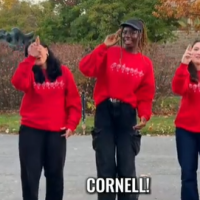When Naomi Enzinna read a newspaper story that claimed Miami was developing its own dialect, she wanted to test out the theory for herself. Four years and a qualifying paper later, Enzinna’s research has found that Miami English does have some Spanish-like features. Her dissertation is focused on finding out how and why those variations occur.
A doctoral student in linguistics, Enzinna is from Miami and knew she had the connections to plan a dissertation expanding on the work of her qualifying paper, which found that the speech of English-only speakers living in communities with a high proportion of Spanish speakers was undergoing measurable changes.
“U.S. Census projections show that before 2050, today’s minority groups will actually be the majority,” Enzinna said. “So the number of bilinguals in the United States will continue to grow, and there will be more language variation at a faster and faster rate. My work can provide insights into how language change occurs and the variation we might see in the future.”
Previous research has shown that people vary their speech, making it more or less like the person they’re speaking with, depending on whether they want to identify or distance themselves from the person. When speaking with bilingual people, Enzinna predicts speakers who have more exposure to people who speak both English and Spanish will vary their speech more and do it more quickly than speakers who have less exposure to bilinguals.
Enzinna’s research is taking her to Miami this summer, where she will work with 40 people on an experiment that records their speech when they’re talking with an English-only speaker and when they’re talking with someone who is bilingual in English and Spanish. She’ll conduct the same experiment with 40 people in Ithaca when she returns later in the fall.
To develop the experiment, she had to create a computer program (with help from Sam Tilsen, assistant professor of linguistics) that participants will use. Participants will listen to two voices that have been recorded, responding verbally and interacting with the program. The program records their responses and helps to analyze the recordings for altered speech – including changes in consonants, vowels, rhythm and pitch.
“It’s taken a long time to get it to work, but it’s finally there now,” Enzinna said. “I’m expecting the participants from Miami to show more convergence to the Spanish-English bilinguals than the speakers here because they speak to bilinguals more often than the speakers here. But the results are always interesting, no matter what you find.”
Enzinna, whose dissertation chair is linguistics professor Draga Zec, is the first in her family to finish college, so she said her family is always sporting the Cornell gear she sends back home. Her long-term goal is to become a professor or work in another industry to continue to study language.
“Research from my qualifying paper shows that Miami is developing its own dialect,” she said. “And more and more places are going to look like Miami, so I think my dissertation can give some insight into how that process happens over time.”
This story also appeared in the Cornell Chronicle.






